Pest ID
Below are some of the common pests that often are problematic and warrant control. Click on any of the below pests for more information. Call us anytime for pest identification and treatment options for your residential or commercial property.
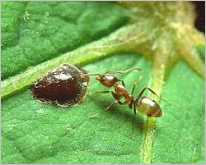
Argentine Ants
Argentine ants are a common household pest, often entering structures in search of food or water (particularly during dry or hot weather), or to escape flooded nests during periods of heavy rainfall. Argentine ant colonies almost invariably have many reproductive queens, as many as eight for every 1,000 workers, so eliminating a single queen does not stop the colony's ability to breed. When they invade a kitchen, it is not uncommon to see two or three queens foraging along with the workers.
The worker ants are only about 3 mm (1/8th inch) long and can easily squeeze through cracks and holes no more than 1 mm (0.040 inch) in size. Queens are two to four times the length of workers. These tiny ants will set up quarters in the ground, in cracks in concrete walls, in spaces between boards and timbers, even among belongings in human dwellings.
Argentine ants also cause problems in agricultural areas by protecting plant pests, such as aphids and scale insects, from predators and parasitoids. In return for this protection, the ants receive a sweet excretion, known as "honeydew."
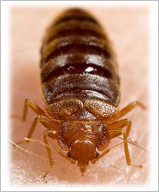
Bed Bugs
Bed bugs are universal pests of humans and domestic animals, as well as of bats, birds, and various other mammals. The sole food of bed bugs is the blood of warm-blooded animal. Adult bed bugs are a reddish-brown, flattened, oval, and wingless, with microscopic hairs that give them a banded appearance.
A common misconception is that they are not visible to the naked eye. Adults grow to 1/8th - 3/16th of an inch in length and do not move quickly enough to escape the notice of an attentive observer.
Bed bugs are generally active only at dawn, with a peak feeding period about an hour before sunrise. They may attempt to feed at other times, however, given the opportunity, and have been observed to feed at any time of the day.
Attracted by warmth and the presence of carbon dioxide, the bug pierces the skin of its host with two hollow tubes. With one tube it injects its saliva, which contains anticoagulants and anesthetics, while with the other it withdraws the blood of its host. After feeding for about five minutes, the bug returns to its hiding place.
The bites cannot usually be felt until some minutes or hours later, as a dermatological reaction to the injected agents, and the first indication of a bite usually comes from the desire to scratch the bite site.
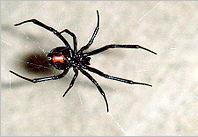
Black Widow
The black and brown widows are widely distributed over the warmer portions of the United States. Females are easily identified because of their globular, shiny black or brown abdomen with two reddish or yellowish triangles on the underside. These reddish or yellowish triangles form a characteristic hourglass marking. The abdomen is about 1/4 inch in diameter but may be as large as 1/2 inch when the female is full of eggs. Males are much smaller and lighter colored, with light streaks on their abdomens.
Widow spider venom contains toxins that are neurotoxic (affects the nervous system). The severity of a person's reaction to the bite depends on the area of the body where the bite occurs; the person's size and general sensitivity; the amount of venom injected; depth of bite; seasonal changes (in venom potency); and temperature. The bite produces a sharp pain similar to a needle puncture. The pain usually disappears rapidly. Local muscular cramps are felt 15 minutes to several hours after the bite, spreading and becoming more severe as time passes. The venom then grows weak, tremors develop, and the abdominal muscles show a board-like rigidity. Respiration becomes spasmodic and the patient is restless and anxious. During this period, a feeble pulse, cold skin, labored breathing and speech, light stupor, and delirium may be noted. Convulsions and death may result with some victims, especially if the person is sensitive to the venom and no treatment is received. An anti-venom specific for the black or brown widow is readily available to most physicians.
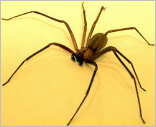
Brown Recluse
The brown recluse spider is a well-known member of the family Sicariidae (formerly placed in a family "Loxoscelidae"). It is usually between 6-20 mm (¼ in and ¾ in), but may grow larger. It is brown and sometimes an almost deep yellow color and usually has markings on the dorsal side of its cephalothorax, with a black line coming from it that looks like a violin with the neck of the violin pointing to the rear of the spider, resulting in the nicknames fiddleback spider, brown fiddler or violin spider.
Coloring varies from light tan to brown and the violin marking may not be visible. This spider is known primarily for its venom, which occasionally produces necrosis at the site of the bite.
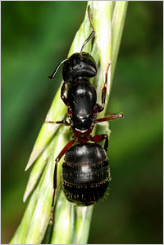
Carpenter Ant
Carpenter ants are large ants (¼ in – 1 in) indigenous to many parts of the world. They prefer dead, damp wood in which to build nests. Sometimes carpenter ants will hollow out sections of trees.
The most likely species to be infesting a house in the United States is the black carpenter ant. It resides both outdoors and indoors in moist, decaying or hollow wood. They cut "galleries" into the wood grain to provide passageways for movement from section to section of the nest.
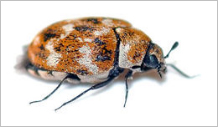
Carpet Beetle
Several species of carpet beetles may damage fabrics. Four species are most commonly encountered-the black carpet beetle, varied carpet beetle, common carpet beetle, and furniture carpet beetle.
Carpet beetles are normally associated with things such as carpets, wool, furs, and any processed animal or plant food. Their appetite also includes dead insects, spiders, and even nectar and pollen. They are typically found throughout the United States and Canada. Females can lay up to 40 eggs and the number of larval instars range from 7-8 stages. The time it takes to become an adult varies from about 8 months to a year. In addition, the adults can live around 2 to 6 weeks. This species varies in shape, size, color, and pattern of scales. On average, the adults are 2 to 3 mm in length and have scales that vary from white, brown, yellow, or even gray-yellow.
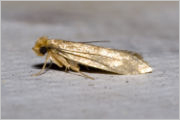
Clothes Moth
The term "clothes moth" is properly used in connection with the webbing clothes moth, the casemaking clothes moth, and the tapestry or carpet moth. The first two species are more common, while tapestry moths occur only infrequently. These are all small moths, as adults have a wingspread of less than ½ inch. Their habits are different from most moths because they are rarely seen flying around lights at night. Rather, they prefer dark closets, attics, or other areas and tend to live in dark corners, or in folds of fabric. They will fly occasionally, but normally only on the edges of a lighted area, so usually remain quite inconspicuous.
The clothing moth and the case-bearing clothes moth (Tinea pellionella) are notorious for feeding on clothing and natural fibers; they have the ability to turn keratin, a protein present in hair and wool, into food. Clothing moths prefer dirty fabric and are particularly attracted to carpeting and clothing that contain human sweat or other liquids which have been spilled onto them. They are attracted to these areas not for the food, but for the moisture. Moth larvae do not drink water; consequently their food must contain moisture. Fabric-destroying insects cause much damage each year. In addition to large losses in commercial fabric manufacturing and storage operations, the many small damages caused in households add up to a significant figure.
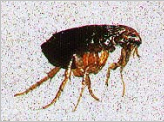
Flea
Fleas are external parasites, living by hematophagy off the blood of mammals and birds. Fleas are small (1/16 to 1/8 long), agile, usually dark colored (for example, the reddish-brown of the cat flea), wingless insects with tube-like mouthparts adapted to feeding on the blood of their hosts. Their bodies are laterally compressed (that is, flattened side to side), permitting easy movement through the hairs or feathers on the host's body (or in the case of humans, under clothes).
Their legs are long, the hind pair well-adapted for jumping (vertically up to seven inches; horizontally thirteen inches) around 200 times their own body length, making the flea the best jumper out of all animals (in comparison to body size). The flea body is hard, polished, and covered with many hairs and short spines directed backward, which also assists its movements on the host. Its tough body is able to withstand great pressure, likely an adaptation to survive scratching, etc. Even hard squeezing between the fingers is normally insufficient to kill the flea.
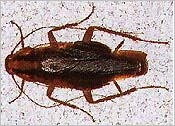
German Cockroach
German cockroach is a relatively active species, moving around readily within structures. They travel from one location to another and can pass through very small openings. They are also regularly carried from place to place in such things as bagged potatoes and onions, beverage cartons, grocery bags, food cans, other food packages, handbags, and the folds of clothing.
Adults are pale to medium brown and about ½ – to ⅝ inch long. German cockroaches can be distinguished from other roaches by the two dark stripes on the back of their head. German cockroach nymphs resemble the adults except that they are smaller, wingless, and darker in color, often being nearly black. A single light stripe running down the middle of the back is the most prominent marking on the young cockroach.
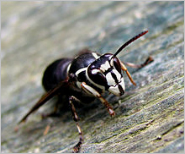
Hornet
The bald-faced hornet lives throughout North America. They are best known for their large football-shaped paper nest, which they build in the spring for raising their young. These nests can sometimes reach 3 feet tall. Bald-faced hornets are extremely protective of their nests and will sting repeatedly if disturbed. The main area of the body that bald faced hornets attack on humans is the facial area.
Every year young queens that were born and fertilized the previous year start a new colony and raise their young. The workers expand the nest by chewing up wood that mixes with a starch in their saliva, which they spread with their mandibles and legs to dry into paper. The workers also guard the nest and collect nectar and arthropods to feed the larvae. This continues through summer and into fall. As winter approaches, the wasps die, except for young fertilized queens which hibernate underground or in hollow trees. The nest is generally abandoned by winter, and will most likely not be reused. When spring arrives the young queens emerge, and the cycle begins again. As in all stinging wasps, hornets can sting multiple times – they do not die after stinging a human, as is typical for a worker honey bee, as the sting is not barbed (the honey bee stinger has evolved for defending the nest against vertebrates/mammals). They can also bite and sting at the same time.
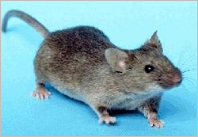
House Mouse
House mice have an adult body length (nose to base of tail) of 3.0–3.9 inches) and a tail length (2.0–3.9 in.); the weight is typically 10–25 g. They vary from light brown to black, with short hair and a light belly. The ears and tail have little hair. The hind feet are short. They can jump up to 18 inches. The droppings are blackish, about 0.12 inches long, and have a strong musty smell. The voice is a high-pitched squeak.
Mice are mostly active during dusk or night; they do not like bright lights. They live in a wide variety of hidden places that are near food sources and construct nests from various soft materials. Mice are territorial and one dominant male usually lives together with several females and young.
House mice primarily feed on plant matter, but they will also accept meat and dairy products. They will drink water but require little of it, relying mainly on the moisture present in their food. They will eat their droppings to acquire nutrients produced by bacteria in their guts.
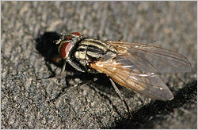
Housefly
The housefly (also house fly, house-fly or common housefly), Musca domestica, is the most common of all flies fluttering in homes, and indeed one of the most widely distributed insects; it is a pest that can carry serious diseases.
The housefly is commonly found in almost all dwellings occupied by humans or animals. The housefly is a very fast breeder with the female laying up to 150 eggs at a time on 5 – 6 day intervals. House fly populations can literally explode in just a few short weeks. Eggs are commonly laid in rotting garbage, organic matter, etc. The complete housefly life cycle can complete itself in as little as 3 – 5 days with adult flies living on average for up to 1 – 2 months. Several generations of flies can be produced in 1 season.
Adult houseflies eat food by use of a sponging mouthpart. It eats by regurgitating its food and then "sopping" it up with its mouthpart. Houseflies have long been suspected of spreading disease causing organisms, primarily by contacting germs and bacteria and by picking them up on their outer body. Houseflies then spread these germs or bacteria by simply landing on surfaces or food. It is for this reason that house flies are of such significant importance - their germ spreading habits make them a concern for everyone, particularly people involved in sanitation or sterilization programs. Houseflies cannot be tolerated and should be the # 1 pest of importance in hospitals, food manufacturing facilities, restaurants, bars, day care centers, nursing homes, not to mention residences.
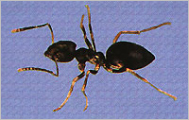
Odorous Ant
This species is a scavenger/predator ant that will eat most household foods, especially those that contain sugar, and other insects. Indoors they will colonize near heat sources or in insulation. In hot and dry situations, nests have been found in house plants and even in the lids of toilets. Outdoors they tend to colonize under rocks and exposed soil. They can trail extensive distances, usually along landscape edges. Colonies range in size from 100-10,000, and house several queens. They are non-aggressive. Queens lay one egg per day. Typical time to adult phase of development is 34–38 days. They range in color from brown to black and range in length from 1/16 to 1/8 inches. Their antennae have 12 segments and are not terminated with a club. The common names "odorous house ant" and "coconut ant" come from the odor the ants produce when crushed, which is very similar to the pungent odor of a coconut.
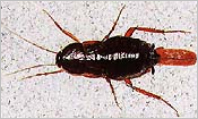
Oriental Roach
Cockroaches are among the most common insects. Based on fossil evidence, roaches are known to have been present on Earth for over 300 million years. Their sizes vary considerably; some species are up to several inches long. Some biologists consider insects to be one of the most successful groups of animals to ever inhabit this planet, and cockroaches are one of the most adaptable and successful insect groups. They have been able to survive many changing environments over millions of years.
The oriental cockroach is also referred to as the waterbug, black beetle or shad roach. It is found in all parts of the United States. Total length of this cockroach is about 1.25 inches for the female and 1 inch for the male. The female has small, functionless rudimentary wings called wing pads. The male's wings cover about ¾ of the abdomen. Neither the male nor the female can fly. Adults are very dark brown or nearly black, and usually have a somewhat greasy sheen to their body. Females are broader and heavier looking than males.
Oriental cockroaches feed on all kinds of filth, rubbish and other decaying organic matter. They seem especially fond of garbage and the contents of discarded tin cans. If water is available, they can live for a month without food, but die within two weeks without water.
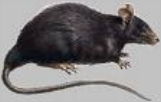
Rat
There are 3 main species of rats and mice that are of significance in the United States. They are the Roof Rat or tree Rat, the Norway Rat or ground rat, and the House Mouse. Of course there are lots of other species such as field mice, field rats, wharf rats, sewer rats, etc., but the Roof Rats, Norway Rats and the House Mouse are the ones of primary importance and the ones that homeowners and building owners deal with 90% of the time. Rats are generally distinguished from mice by their size; rats generally have bodies longer than 5 inches. Rats can carry a number of diseases and parasites.
Rats are animals that are capable of crawling, climbing, and chewing their way into your home or business. They can flatten themselves out and squeeze through the smallest of openings, even under closed doors. If the hole is not big enough, they can easily chew it or gnaw it to a large enough size so that they can get through. Generally, if a rodent can squeeze its head through an opening, (most rodents’ heads are the size of a quarter or smaller), it will eventually get through. This is why your strategy for rat or mice control always starts on the outside of the structure.
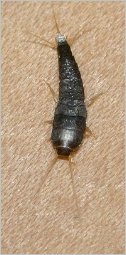
Silverfish
Commonly called the fishmoth, urban silverfish or just the silverfish is a small, wingless insect typically measuring from a half to one inch. Its common name derives from the animal's silvery blue color, combined with the fish-like appearance of its movements.
The favorite food of silverfish is any matter that contains starch or polysaccharides, such as dextrin in adhesives. These include glue, book bindings, paper, photos, sugar, hair, and dandruff. Silverfish can also cause damage to books, tapestries, and textiles. Silverfish will commonly graze in and around showers, baths, and sinks on the cellulose present in many shampoos, shaving foams and so on.
During famine, a silverfish may even attack leatherware and synthetic fabrics. In extreme cases, silverfish may live for a year without eating. Silverfish can be found anywhere in homes including, but not limited to, garages, closets, underneath beds, couches, electrical appliances such as keyboards and generally preferring dark areas.
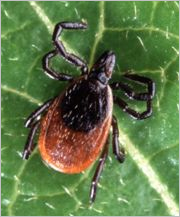
Tick
Tick is the common name for the small arachnids in superfamily Ixodoidea that, along with other mites, constitute the Acarina. Ticks are ectoparasites (external parasites), living by hematophagy on the blood of mammals, birds, and occasionally reptiles and amphibians. Ticks are important vectors of a number of diseases, including Lyme disease, Rocky Mountain spotted fever, Southern tick-associated rash illness, Tick-borne relapsing fever, and Tularemia. Ticks are thought to be among the foulest and nastiest creatures on earth.
Ticks are blood-feeding parasites that are often found in tall grass and shrubs where they will wait to attach to a passing host. Physical contact is the only method of transportation for ticks. Ticks do not jump or fly, although they may drop from their perch and fall onto a host. Some species actively stalk the host by foot.
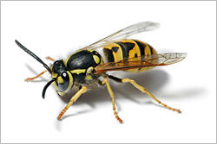
Yellowjacket
Yellowjacket or yellow–jacket is the common name in North America for predatory wasps of the genera Vespula and Dolichovespula. They can be identified by their distinctive markings, small size (similar to or slightly smaller or larger than a honey bee), their occurrence only in colonies, and a characteristic, rapid, side to side flight pattern prior to landing. They are often mistakenly called "bees."
All females are capable of stinging. A typical yellowjacket worker is about 12 mm (0.5 inches) long, with alternating bands on the abdomen while the queen is larger, about 19 mm (0.75 inches) long (the different patterns on the abdomen help separate various species). Workers are sometimes confused with honey bees, especially when flying in and out of their nests. Yellowjackets, in contrast to honey bees, are not covered with tan-brown dense hair on their bodies and lack the flattened hairy hind legs used to carry pollen. Yellowjackets have a lance-like stinger with small barbs and typically sting repeatedly, though occasionally the sting becomes lodged and pulls free of the wasp's body; the venom, like most bee/wasp venoms, is primarily dangerous to those who are allergic.
